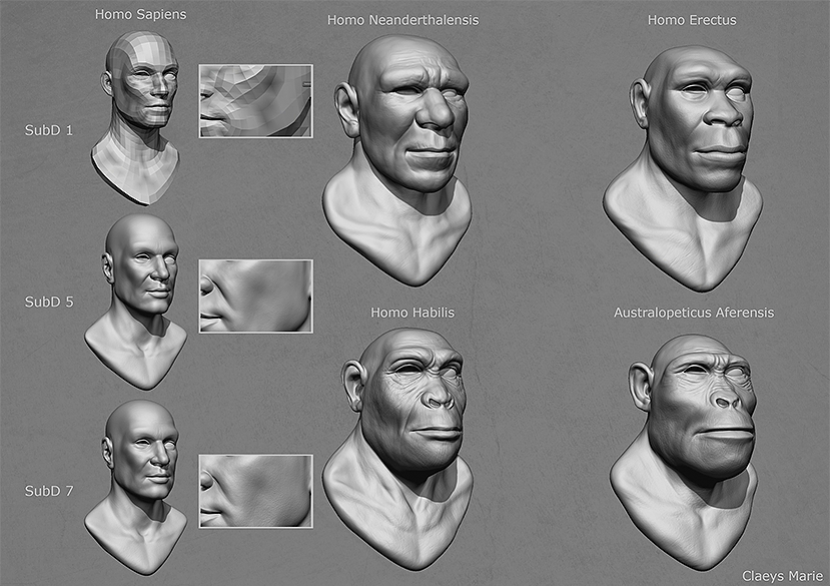The graduation project of Marie Claeys was a 3D visualization of the human evolution, shown by a series of highly detailed sculpted buste figures that represent certain stages in this evolution which are moprhed into each other.
Sculping:
Since sculpting was a small part of this entire project Marie had to review her workflow to make it faster. That is why she worked in 3 phases for each sculpt. On subDivision level 1, she worked mostly on the basic proportions of the bustes, using mostly the Move Brush. SubDivision level 5 was where the new workflow came into play. she used the ClayBuildup Brush to roughly block in the proportions further (Which you can shortly see in the Research Video later on) without smoothing it out. On subDivision 7 she focused on the facial details which she sculpted by using Alpha's.
Polypaint:
In Zbrush, Marie started the polypaint by painting the sub dermal layer first, exaggerating the colors to make sure that they would still have effect in the final polypaint. Her next step was to take a very low intensity RGB brush with a standard spotted alpha to paint the skin color lightlyon top of it. For the Australopeticus Aferensis, she used reference pictures of chimps for the polypaint of both eyes and body.
Fibermesh:
Marie researched how to use Zbrush Fibermesh since she wasn't expierenced in it. First learning how to mask properly to get a smooth transition between hairy and non-hairy and then playing around with all the settings and grooming the fibers was very fun but challenging.
Rendering:
For rendering Marie tried three different software packages: Zbrush BPR, Keyshot and Marmoset Toolbag 2. Marmoset Toolbag 2 required me to make a lot of different maps which weren't standard exportable from Zbrush such a the subdermal map. Instead of painting this is Photoshop, I polypainted the map directely onto the 3d model in Zbrush and exported it as a texture. I did this for several other maps aswell and put them all together in marmoset. The final images where rendered in Zbrush BPR. She used different passes which she then composited in Photoshop for the still renders and Fusion for creating the videors.
Polypaint:
In Zbrush, Marie started the polypaint by painting the sub dermal layer first, exaggerating the colors to make sure that they would still have effect in the final polypaint. Her next step was to take a very low intensity RGB brush with a standard spotted alpha to paint the skin color lightlyon top of it. For the Australopeticus Aferensis, she used reference pictures of chimps for the polypaint of both eyes and body.
Fibermesh:
Marie researched how to use Zbrush Fibermesh since she wasn't expierenced in it. First learning how to mask properly to get a smooth transition between hairy and non-hairy and then playing around with all the settings and grooming the fibers was very fun but challenging.
Rendering:
For rendering Marie tried three different software packages: Zbrush BPR, Keyshot and Marmoset Toolbag 2. Marmoset Toolbag 2 required me to make a lot of different maps which weren't standard exportable from Zbrush such a the subdermal map. Instead of painting this is Photoshop, I polypainted the map directely onto the 3d model in Zbrush and exported it as a texture. I did this for several other maps aswell and put them all together in marmoset. The final images where rendered in Zbrush BPR. She used different passes which she then composited in Photoshop for the still renders and Fusion for creating the videors.
Graduation Work - Research from Marie Claeys on Vimeo.
Graduation Work Final from Marie Claeys on Vimeo.

